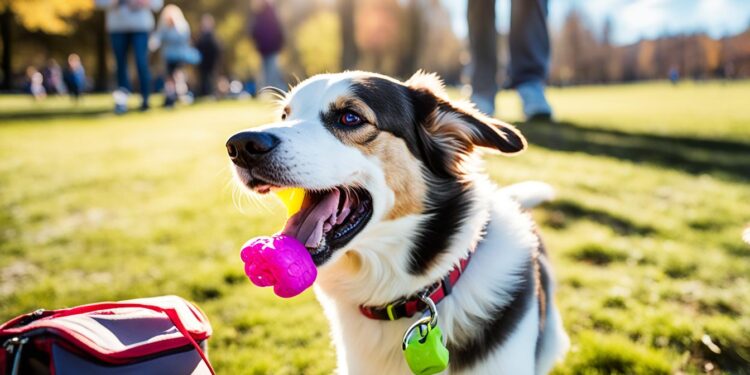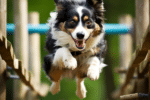Embracing a Dog Lifestyle: Tips for Pet Parents

As a dog owner, I understand the joy and fulfillment that comes with embracing a dog lifestyle. It’s not just about having a pet; it’s about creating a loving and enriching life for both you and your furry friend. From training and nutrition to grooming and exercise, there are many aspects to consider in order to ensure a happy and healthy dog lifestyle.
Key Takeaways:
- Embracing a dog lifestyle goes beyond basic care and involves creating a fulfilling environment for your pet.
- Training is crucial for building a strong bond and ensuring a well-behaved dog.
- A balanced and nutritious diet is essential for your dog’s overall well-being.
- Regular grooming sessions help keep your dog clean, comfortable, and free from potential health issues.
- Providing regular exercise and mental stimulation is vital for your dog’s physical and mental health.
Dog Training: Building a Strong Bond
Training plays a crucial role in shaping a dog’s behavior and strengthening the bond between pet parents and their furry companions. It establishes boundaries, fosters trust, and ensures a well-behaved and happy dog. By investing time and effort into training, you can create a harmonious and fulfilling dog lifestyle experience.
The Importance of Dog Training
Effective dog training is key to nurturing desirable behaviors and curbing unwanted ones. It provides mental stimulation, reduces anxiety, and aids overall development. Whether you have a new puppy or an adult dog, training is essential for their socialization and well-being.
“Training a dog is not just about teaching commands; it’s about building a lifelong partnership based on clear communication and mutual respect.”
Techniques and Tips for Dog Training
Positive reinforcement is a widely endorsed training approach that uses rewards and praise to reinforce good behavior. Incorporating treats, toys, and verbal affirmations can be highly effective in motivating and shaping your dog’s behavior.
To optimize the training experience:
- Be consistent: Set clear expectations for your dog and maintain a consistent training routine.
- Be patient: Dogs learn at their own pace, so patience is key to successful training.
- Provide rewards: Rewards serve as powerful motivators and encourage your dog to repeat desired behaviors.
Addressing Behavioral Issues
Addressing behavioral issues promptly is essential for a harmonious dog lifestyle. If your dog displays signs of aggression, anxiety, or other problem behaviors, it’s crucial to seek professional guidance. A certified dog trainer or animal behaviorist can assess the situation and provide tailored solutions to address the underlying causes of these behaviors.
Building Trust and Strengthening the Bond
Training not only shapes behavior but also deepens the bond between you and your dog. It fosters trust, improves communication, and enhances mutual understanding. Through training sessions, you’ll learn to anticipate your dog’s needs and develop a strong and enduring partnership.
Recommended Training Resources
| Resource | Description |
|---|---|
| 1. Dog Training Basics | A comprehensive guidebook covering essential obedience training techniques and strategies for dog owners of all experience levels. |
| 2. Clicker Training 101 | An instructional video series that demonstrates the effective use of clicker training, a positive reinforcement technique. |
| 3. Puppy Socialization Classes | A group training class designed to socialize puppies, teach basic commands, and address common behavioral problems. |
| 4. One-on-One Training Sessions | Personalized training sessions with a certified dog trainer to address specific behavioral issues or enhance obedience skills. |
Dog Health and Nutrition: Optimal Well-being
A healthy diet is essential for a dog’s overall well-being. As a responsible pet parent, I understand the importance of providing my furry friend with a balanced and nutritious diet. By prioritizing their health and nutrition, I can ensure that they thrive and live a long, happy life.
One of the key aspects of dog health is choosing high-quality dog food. I opt for brands that prioritize real, wholesome ingredients and avoid artificial fillers. By reading the labels and understanding the nutritional components, I can make informed decisions about what goes into my dog’s bowl.
Key Considerations for Dog Nutrition
- Protein-rich diets: Dogs are natural carnivores, and their diets should reflect that. I prioritize dog foods that contain high-quality sources of protein, such as real meat or fish.
- Proper portion sizes: Overfeeding can lead to weight gain and associated health issues. I consult with my veterinarian to determine the appropriate portion sizes for my dog’s age, size, and activity level.
- Vitamins and minerals: Just like humans, dogs require essential vitamins and minerals to maintain optimal health. I ensure that my dog’s food provides a well-balanced array of these nutrients.
To ensure that my dog maintains their optimal well-being, I also prioritize regular veterinary check-ups. These visits allow the veterinarian to monitor my dog’s health, provide necessary vaccinations, and address any concerns or potential issues promptly.
In addition to regular check-ups, preventative measures play a crucial role in maintaining my dog’s health. I understand the importance of flea and tick prevention, as these pests can transmit diseases and cause discomfort for my furry friend. By using vet-recommended preventatives, I can protect my dog from these harmful parasites.

The Benefits of a Healthy Diet
A well-balanced and nutritious diet offers numerous benefits to a dog’s overall well-being:
“A healthy diet can support a dog’s immune system, help maintain their weight, and contribute to their longevity.”
When I prioritize my dog’s health and nutrition, I am investing in their long-term happiness and well-being. By providing them with the nutrients they need, I can ensure that they have the energy to enjoy their daily activities, maintain a healthy weight, and thrive both physically and mentally.
Next, let’s explore the importance of dog grooming and hygiene in maintaining a happy and healthy dog lifestyle.
Dog Grooming and Hygiene: Keeping Your Pup Fresh
Regular grooming is essential for maintaining the cleanliness, comfort, and overall health of your furry friend. By incorporating regular grooming practices into your dog lifestyle, you can ensure that your pup stays fresh and happy. Here are some crucial grooming tips to keep in mind:
- Brushing: Regular brushing is vital for preventing matting and tangles in your dog’s fur. It helps to distribute natural oils, keeps the coat looking shiny, and can also serve as a bonding activity between you and your pup.
- Bathing: Regular bathing helps remove dirt, odors, and allergens from your dog’s coat, promoting cleanliness and freshness. It is important to use dog-friendly shampoos and conditioners and ensure that the water temperature is suitable for your pup.
- Nail Trimming: Keeping your dog’s nails trimmed is crucial for their comfort and mobility. Overgrown nails can cause discomfort and even lead to health issues. Regularly trim your dog’s nails or seek professional help to avoid any accidents or injuries.
Grooming sessions not only contribute to your dog’s physical well-being but also provide an excellent opportunity to strengthen the bond between you and your pet. Enjoy the time spent together, and make grooming a positive experience for both of you.

Dog Exercise and Mental Stimulation: Happy and Active Living
Regular exercise is key to keeping your dog physically and mentally healthy. It not only helps them maintain a healthy weight but also provides mental stimulation that can prevent boredom and behavioral problems. Incorporating daily exercise and engaging in dog-friendly activities will contribute to your furry friend’s overall well-being.
One of the simplest and most effective ways to keep your dog active is through daily walks. Taking your dog for a walk not only provides them with physical exercise but also allows them to explore their surroundings and experience new smells. Aim for at least 30 minutes to an hour of brisk walking each day, depending on your dog’s age, breed, and fitness level.
Interactive play sessions are another great way to keep your dog mentally stimulated and physically active. Playing fetch with a ball or frisbee, engaging in tug-of-war, or using puzzle toys can provide mental challenges and keep their mind sharp. Not only will these activities keep your dog entertained, but they will also strengthen the bond between you and your furry companion.
Dog-Friendly Activities for Added Excitement
In addition to walks and play sessions, there are many dog-friendly activities that you can explore to add excitement and variety to your dog’s exercise routine. These activities cater to different energy levels and interests, ensuring a happy and active lifestyle for your canine companion.
- Hiking: Take your dog on a nature adventure by exploring dog-friendly hiking trails. They will enjoy the sights, sounds, and smells of the great outdoors while getting a good workout.
- Agility Training: If your dog is high-energy and loves to jump, weave, and climb, agility training can be a great option. This activity challenges their physical abilities while reinforcing obedience and providing mental stimulation.
- Swimming: If your dog enjoys the water, swimming is an excellent low-impact exercise that helps build muscle strength and cardiovascular endurance. Find a dog-friendly beach, pool, or lake where you can safely enjoy a swim together.
- Dog Parks: Dog parks are designed to provide a safe and enclosed environment for dogs to play off-leash. They offer opportunities for socialization, exercise, and play with other dogs.
Remember, when engaging in dog-friendly activities, always prioritize your dog’s safety. Ensure that they are up to date with vaccinations, keep them on a leash when necessary, and provide plenty of water to keep them hydrated.
By incorporating regular exercise and engaging in dog-friendly activities, you can promote a happy and active lifestyle for your furry friend. It not only benefits their physical health but also contributes to their mental well-being. So, grab that leash and get ready to embark on exciting adventures with your canine companion!

Conclusion
Embracing a dog lifestyle goes beyond the basics of pet care. It’s about creating a loving and fulfilling environment for your furry friend. By incorporating essential elements such as training, proper nutrition, grooming, exercise, and mental stimulation into your dog lifestyle, you can ensure a happy and healthy life for your beloved pet.
Training is the foundation of a well-behaved dog, strengthening the bond between you and your canine companion. It sets boundaries and establishes good behavior, making everyday interactions more enjoyable. Remember to use positive reinforcement techniques, consistency, and patience to achieve the best results.
Ensuring optimal health and nutrition is vital for your dog’s well-being. Providing a balanced and nutritious diet, along with regular veterinary check-ups, vaccinations, and preventative measures, will help them thrive. Don’t forget to consider their grooming needs to keep them clean, comfortable, and healthy.
Exercise and mental stimulation are key to a happy and active dog lifestyle. Daily walks, interactive play sessions, and engaging in dog-friendly activities keep them physically fit and mentally stimulated, preventing boredom and behavioral issues. To add an extra touch of enjoyment, consider investing in dog accessories like toys, beds, and collars that enhance their comfort and enrich their lives.
FAQ
What are some basic obedience commands I can teach my dog?
Some basic obedience commands you can teach your dog include sit, stay, and come. These commands can be taught using positive reinforcement techniques, such as rewards and praise.
How can I address behavioral issues in my dog?
Addressing behavioral issues in your dog is important for creating a positive dog lifestyle. By seeking professional help, such as a certified dog trainer or behaviorist, you can identify the root cause of the behavior and develop a plan to correct it.
What should I include in my dog’s diet for optimal health?
To ensure optimal health in your dog, provide a balanced and nutritious diet consisting of high-quality dog food. Consult with your veterinarian to determine the appropriate portion sizes and consider supplementing their diet with fresh fruits and vegetables.
How often should I groom my dog?
The frequency of grooming your dog depends on their breed and coat type. Generally, regular brushing to prevent matting and tangles should be done at least once a week. Bathing can be done every 4-8 weeks or as needed, and nail trimming should be done every 4-6 weeks.
How much exercise does my dog need?
The amount of exercise your dog needs will depend on their age, breed, and energy level. As a general guideline, dogs should have at least 30 minutes to 2 hours of exercise daily. This can be in the form of daily walks, playtime, or engaging in dog-friendly activities.
What are some dog-friendly activities I can do with my dog?
There are several dog-friendly activities you can do with your furry friend to enhance their dog lifestyle. Some examples include hiking, agility training, playing fetch, swimming, or participating in obedience or scent training classes.
What are some essential dog accessories?
Essential dog accessories include a comfortable bed, a properly fitted collar or harness, high-quality toys for mental stimulation, and grooming tools. Consider your dog’s specific needs and preferences when selecting accessories to enhance their comfort and enjoyment.






